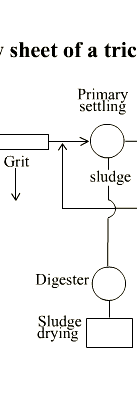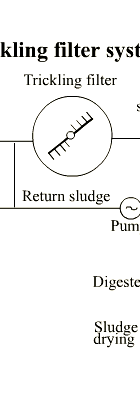Home
Lecture
Quiz
Design Example |
Trickling Filters
Process Description
Types of Filters
Process Design
Trickling Filters
Trickling filter is an attached growth process i.e. process in which microorganisms responsible for treatment are attached to an inert packing material. Packing material used in attached growth processes include rock, gravel, slag, sand, redwood, and a wide range of plastic and other synthetic materials.
    
Process Description
- The wastewater in trickling filter is distributed over the top area of a vessel containing non-submerged packing material.
- Air circulation in the void space, by either natural draft or blowers, provides oxygen for the microorganisms growing as an attached biofilm.
- During operation, the organic material present in the wastewater is metabolised by the biomass attached to the medium. The biological slime grows in thickness as the organic matter abstracted from the flowing wastewater is synthesized into new cellular material.
- The thickness of the aerobic layer is limited by the depth of penetration of oxygen into the microbial layer.
- The micro-organisms near the medium face enter the endogenous phase as the substrate is metabolised before it can reach the micro-organisms near the medium face as a result of increased thickness of the slime layer and loose their ability to cling to the media surface. The liquid then washes the slime off the medium and a new slime layer starts to grow. This phenomenon of losing the slime layer is called sloughing.
- The sloughed off film and treated wastewater are collected by an underdrainage which also allows circulation of air through filter. The collected liquid is passed to a settling tank used for solid- liquid separation.
Types of Filters
Trickling filters are classified as high rate or low rate, based on the organic and hydraulic loading applied to the unit.
S.No. |
Design Feature |
Low Rate Filter |
High Rate Filter |
1. |
Hydraulic loading, m3/m2.d |
1 - 4 |
10 - 40 |
2. |
Organic loading,kg BOD / m3.d |
0.08 - 0.32 |
0.32 - 1.0 |
3. |
Depth, m. |
1.8 - 3.0 |
0.9 - 2.5 |
4. |
Recirculation ratio |
0 |
0.5 - 3.0 (domestic wastewater) upto 8 for strong industrial wastewater. |
- The hydraulic loading rate is the total flow including recirculation appied on unit area of the filter in a day, while the organic loading rate is the 5 day 20°C BOD, excluding the BOD of the recirculant, applied per unit volume in a day.
- Recirculation is generally not adopted in low rate filters.
- A well operated low rate trickling filter in combination with secondary settling tank may remove 75 to 90% BOD and produce highly nitrified effluent. It is suitable for treatment of low to medium strength domestic wastewaters.
- The high rate trickling filter, single stage or two stage are recommended for medium to relatively high strength domestic and industrial wastewater. The BOD removal efficiency is around 75 to 90% but the effluent is only partially nitrified.
- Single stage unit consists of a primary settling tank, filter, secondary settling tank and facilities for recirculation of the effluent. Two stage filters consist of two filters in series with a primary settling tank, an intermediate settling tank which may be omitted in certain cases and a final settling tank.
Process Design
   
Generally trickling filter design is based on empirical relationships to find the required filter volume for a designed degree of wastewater treatment. Types of equations:
- NRC equations (National Research Council of USA)
- Rankins equation
- Eckenfilder equation
- Galler and Gotaas equation
NRC and Rankin's equations are commonly used. NRC equations give satisfactory values when there is no re-circulation, the seasonal variations in temperature are not large and fluctuations with high organic loading. Rankin's equation is used for high rate filters.
NRC equations: These equations are applicable to both low rate and high rate filters. The efficiency of single stage or first stage of two stage filters, E2 is given by
E2= 100
1+0.44(F1.BOD/V1.Rf1)1/2
For the second stage filter, the efficiency E3 is given by
E3= 100
[(1+0.44)/(1- E2)](F2.BOD/V2.Rf2)1/2
where E2= % efficiency in BOD removal of single stage or first stage of two-stage filter, E3=% efficiency of second stage filter, F1.BOD= BOD loading of settled raw sewage in single stage of the two-stage filter in kg/d, F2.BOD= F1.BOD(1- E2)= BOD loading on second-stage filter in kg/d, V1= volume of first stage filter, m3; V2= volume of second stage filter, m3; Rf1= Recirculation factor for first stage, R1= Recirculation ratio for first stage filter, Rf2= Recirculation factor for second stage, R2= Recirculation ratio for second stage filter.
Rankins equation: This equation also known as Tentative Method of Ten States USA has been successfully used over wide range of temperature. It requires following conditions to be observed for single stage filters:
- Raw settled domestic sewage BOD applied to filters should not exceed 1.2 kg BOD5/day/ m3 filter volume.
- Hydraulic load (including recirculation) should not exceed 30 m3/m2 filter surface-day.
- Recirculation ratio (R/Q) should be such that BOD entering filter (including recirculation) is not more than three times the BOD expected in effluent. This implies that as long as the above conditions are satisfied efficiency is only a function of recirculation and is given by:
E = (R/Q) + 1
(R/Q) + 1.5
Design Example
. |